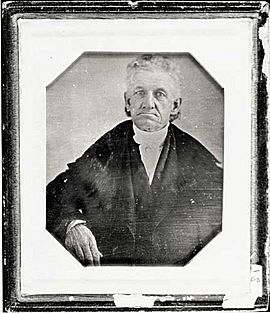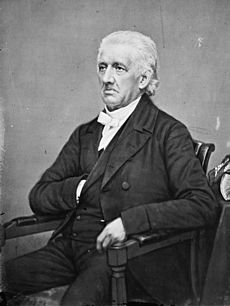Lyman Beecher facts for kids
Quick facts for kids
Lyman Beecher
|
|
|---|---|
 |
|
| Born | October 12, 1775 |
| Died | January 10, 1863 (aged 87) |
| Occupation | Minister |
| Spouse(s) |
Roxana Foote
(m. 1799; Harriet Porter
(m. 1817; Lydia Beals
(m. 1836) |
| Children | Catharine Esther, William, Edward, Mary, Tommy, George, Harriet Elisabeth, Henry Ward, Charles, Frederick, Isabella, Thomas, James |
| Parent(s) | David Beecher Esther Hawley Lyman |
| Family | Beecher |
Lyman Beecher (born October 12, 1775 – died January 10, 1863) was an important Presbyterian minister. He was the father of 13 children. Many of his children became famous in their own right. These include Harriet Beecher Stowe, who wrote "Uncle Tom's Cabin", and Henry Ward Beecher, another well-known minister. Other notable children were Charles Beecher, Edward Beecher, Isabella Beecher Hooker, Catharine Beecher, and Thomas K. Beecher.
Contents
Early Life and Education
Lyman Beecher was born in New Haven, Connecticut. His father, David Beecher, was a blacksmith. His mother, Esther Hawley Lyman, died soon after he was born. He was raised by his uncle, Lot Benton, who adopted him. Lyman spent his early years helping with blacksmithing and farming.
However, he soon showed a strong interest in studying. He prepared for college with the help of Rev. Thomas W. Bray. At 18, he entered Yale College and graduated in 1797. He continued his studies at Yale in 1798, learning from his teacher Timothy Dwight.
Ministry Work
Starting Ministry on Long Island (1798–1810)
In September 1798, Lyman Beecher was allowed to preach. He began his work at the Presbyterian church in East Hampton, Long Island. He was officially ordained as a minister in 1799. Here, he married his first wife, Roxana Foote.
His salary was small, only $300 a year, later increasing to $400. To earn more money, his wife opened a private school where he also taught. After a famous duel between Aaron Burr and Alexander Hamilton in 1804, Beecher became well-known. He gave a sermon called The Remedy for Duelling in 1806, which was quickly published.
Ministry in Litchfield, Connecticut (1810–1826)
Because his family was growing, Beecher needed more income. He left East Hampton and moved to Litchfield, Connecticut, in 1810. For 16 years, he served as a minister at the First Congregational Church of Litchfield. Here, he began to preach about Calvinism, a type of Protestant faith. He bought a home and raised his large family there.
Taking a Stand Against Alcohol
Heavy drinking was a big problem in New England and other parts of the United States. Lyman Beecher decided to speak out against it. In 1826, he gave and published six sermons about the dangers of drinking too much alcohol. These sermons were shared across the United States. They were also printed many times in England and translated into several languages in Europe. They remained popular for many years.
Religious Debates and Women's Education
While Beecher was in Litchfield, a big religious debate started. This was called the Unitarian controversy. Beecher played an important role in this discussion. Litchfield was also home to the famous Litchfield Law School and other schools. Beecher and his wife helped educate several young women by inviting them to live in their home. However, his annual salary of $800 was still not enough.
Ministry in Boston (1826–1832)
Many Congregational churches in Boston were changing their beliefs. This worried many people in New England. In 1826, Beecher was asked to lead Hanover Church in Boston. He began preaching against Unitarianism, a different religious view that was becoming popular there.
Leading Lane Seminary in Cincinnati (1832–1852)
People across the country realized how important the western United States was becoming. A special school for training ministers, called Lane Seminary, was founded near Cincinnati, Ohio. It was named after one of its main supporters. Beecher's church in Boston was damaged by fire in 1830. The leaders of Lane Seminary hoped this would make him consider moving. They offered him the presidency of the school in 1830, with a salary of $20,000. He first turned it down but accepted a second offer in 1832.
His main goal at Lane Seminary was to train ministers. These ministers would help spread Protestantism in the West. Besides being president, he was also a professor of religious studies. He also served as a pastor at the Second Presbyterian Church of Cincinnati for the first ten years of his time at Lane.
Beecher was also known for his strong views against the Catholic Church. Soon after arriving in Cincinnati, he wrote a pamphlet called "A Plea for the West." This pamphlet talked about the importance of American-born citizens. In 1834, his sermon in Boston was followed by the burning of the Catholic Ursuline Sisters' convent there. Some people blamed Lyman Beecher. However, he stated that the sermon was given far from the convent and that the rioters likely had not heard it. Still, the convent was burned at a time when Beecher was warning Massachusetts about what he saw as dangers from the Catholic Church.
Lane Debates on Slavery
Beecher's time at Lane Seminary happened when slavery became a huge issue. This issue threatened to divide the Presbyterian Church, the state of Ohio, and the entire country.
Like many important men in the 1820s, Beecher supported the idea of colonization. This was a plan by the American Colonization Society to help free Black people move to West Africa and start a colony there. He seemed to support the idea of debates on this topic at Lane. However, he also spoke at meetings of the Cincinnati Colonization Society, defending their work. He tried to show that those who wanted to end slavery could work with the Colonization Society.
But news about the harsh treatment of American slaves began to spread. John Rankin's Letters on Slavery brought attention to the wrongs of slavery. A new group, the American Anti-Slavery Society, held its first meeting in Philadelphia in 1833. Its president, Arthur Tappan, who had given money to help Beecher lead Lane Seminary, sent a copy of the society's message to the students. Soon, the topic of slavery was being discussed everywhere.
In February 1834, students at Lane Seminary held debates about colonization for 18 nights in a row. They discussed whether the American Colonization Society, which wanted to send freed slaves to Africa, was a good idea. The students did not have official permission for these debates, but they were not stopped beforehand. Most of them decided that colonization was not a real solution. Instead, they became strong supporters of abolitionism, which meant ending slavery completely.
Many students at Lane were from the Southern states. Efforts were made to stop the discussions and meetings. Slaveholders from Kentucky came and caused angry crowds. For several weeks, Beecher was very worried. He didn't know if rioters might destroy the seminary or the professors' homes. The school's Board of Trustees stepped in while Beecher was away. They calmed the angry crowd by banning all further discussions about slavery at the seminary, even during meals. Because of this, about 50 students, known as the Lane Rebels, left the seminary all together. They went to the new Oberlin Collegiate Institute, leaving Lane with very few students. Beecher believed he was not to blame for this.
These widely reported events greatly helped the growth of abolitionism in the northern United States. Beecher himself was not fully aware of Lane's important role in making abolitionism known to the public.
Move to New York City (1852–1863)
After the slavery debates, Beecher and his colleague Calvin Ellis Stowe stayed and tried to help the seminary recover. But eventually, they gave up. Their big project had failed. They returned to the East, where Beecher went to live with his son Henry in Brooklyn, New York, in 1852. He wanted to spend his time revising and publishing his writings.
However, his mind began to decline, even though his body was still strong. Around his 80th birthday, he suffered a stroke. After that, his mental abilities only showed up sometimes. He spent his last years living with his children. Lyman Beecher died in Brooklyn in 1863 and was buried in Grove Street Cemetery in New Haven, Connecticut.
Legacy
Lyman Beecher was known for being often forgetful. After an exciting sermon, he would relax by playing "Auld Lang Syne" on his violin or dancing in his living room.
The Harriet Beecher Stowe House in Cincinnati, Ohio, was the home of Lyman Beecher. It was located on the former campus of the Lane Theological Seminary. Harriet lived there until she got married. It is the only building of Lane Seminary that is still standing. Today, it is open to the public as a historical and cultural site. It focuses on Harriet Beecher Stowe, the Lane Theological Seminary, and the Underground Railroad. The site also shares information about African-American history. The Harriet Beecher Stowe House is at 2950 Gilbert Avenue, in Cincinnati, Ohio.
Personal Life
In 1799, Lyman Beecher married Roxana Foote. They had nine children: Catharine Esther, William Henry, Edward, Mary, Harriet (who died as a baby), George, Harriet Elisabeth, Henry Ward, and Charles. Roxana passed away in 1816.
The next year, he married Harriet Porter. They had four more children: Frederick C., Isabella Holmes, Thomas Kinnicut, and James Chaplin. Out of Lyman Beecher's thirteen children, nine became writers. Harriet Porter Beecher died in 1835.
In 1836, he married Lydia Beals. Lydia had been married before. Lydia and Beecher did not have any children together.
Images for kids




